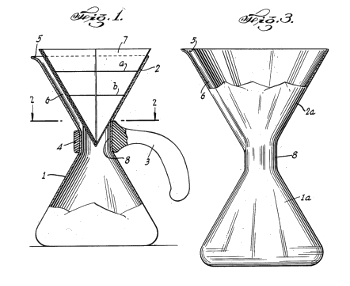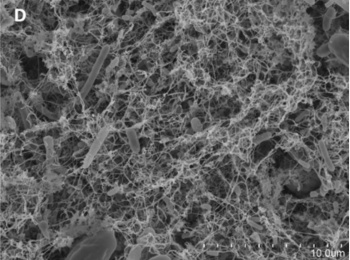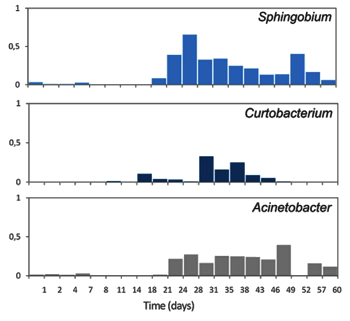Caffeine-Resistant Bacteria
January 7, 2016
The
industrial revolution was
fueled by
coal, but our
information age is fueled by
coffee. We drink so much coffee that
environmental caffeine is a good indicator of
human presence. As the
earliest riser in our
research group, it was my responsibility to make the first pot of the
morning. I was happy to do this, since I took more care in
cleaning and
brewing than most others, perhaps because of my many years of working in a
materials laboratory. I also got to drink my coffee while it was still fresh.
During one of my visits to
Bell Labs in the 1970s, I was treated to one research group's coffee. They had taken a
scientific approach to the problem of keeping coffee fresh on the
hot plate by reasoning that
stale coffee was caused by
oxidation. As a consequence, they flowed
nitrogen gas, a convenient laboratory utility, into the open pot to displace the
oxygen. As I remember, this process worked well.

A nice cup of coffee.
Since a cup's volume is defined as 8 ounces, serious coffee drinkers will opt for a 12 ounce, or a 16 ounce, mug.
(Wikimedia Commons image.)
In the 1980s, as research laboratories became more
safety conscious, lab-brewed coffee was prohibited for some very obvious reasons, and we were forced to use the same coffee stations as our non-scientist
colleagues. Eventually, those
drip-style coffeemakers gave way to the single-serving types that are now common. As a coffee
connoisseur, I've always preferred coffee made using
vacuum coffee makers, or the
Chemex process.
Chemex coffee, preferred by such "
manly men" as
Don Draper and
James Bond, was the
invention of the
German chemist,
Peter Schlumbohm. The Chemex process is essentially a drip coffee process using a thicker
filter paper than others. The Chemex coffee pot has its
conical filter holder and coffee pot integrated as one piece of
glass. At one time I used a variant process that utilized a large plastic funnel and a standard pot. Now I use a
Bunn, which is a step up from the typical coffeemaker.

The Chemex Coffeemaker.
Figs. 1 and 3 from US Patent No. 2,241,368, "Filtering Device," by Peter Schlumbohm, May 6, 1941.
(Via Google Patents.[1]
Our
corporate coffeemaker was generally clean due to my efforts, but most others are not.
Biologists at the
University of Valencia (Universitat de València, Valencia, Spain) have
published a study on the
bacteria they found populating the coffee waste reservoirs of ten different
pod-type coffeemakers, and they also monitored the bacterial
colonization process in a new coffeemaker.[2-4]
The research team
sequenced the
ribosomal RNA of the residue, and they were able to identify 59 bacterial
genera with abundance greater than 0.01%.[3] This is a surprising result, since caffeine (
1,3,7-trimethylxanthine), a natural
alkaloid present in coffee, has
antibacterial properties.[2] As a
control check, they detected no
cultivable microorganisms or bacterial
DNA in the coffee itself, so the bacteria must have originated from the environment and grew under the warm and
moist conditions present in the coffeemaker.[2]

Scanning electron micrograph of coffeemaker bacteria after 21 days of operation.
(Fig. 4D of ref. 2, published under a Creative Commons Attribution 4.0 International License.[2]
In examining the
temporal progression of bacterial
species, there appeared to be a succession from generalist bacteria to bacteria apparently
adapted to the coffeemaker
environment.[2,4] This final bacterial pool is consistent with the bacteria types normally associated with the
coffee plant and its subsequent processing.[2] In particular,
Pseudomonas bacteria, a known caffeine-degrading bacterium was found.[2,4]

Bacterial colonization in a brand new Nespresso Krups Inissia machine. The ecological succession of some bacterial taxa is shown by their relative frequencies.
(Portion of fig. 2B of ref. 2, published under a Creative Commons Attribution 4.0 International License.[2]
The
authors advise that only careful cleaning of coffeemakers with
bacteriostatic compounds, and avoiding contact of the drip waste with other parts of the coffeemaker, will prevent possible contamination of your
beverage.[2] There might be a positive side to all this. Such bacteria might be effective in
decaffeination without the use of
solvents, and for environmental clean-up of
contaminated soil.[2,4]
Another
biohazard of coffee has been discovered by other
scientists at the University of Valencia. They detected
mycotoxins in an
analysis of a hundred commercial coffee
brands sold in
Spain by
liquid chromatography tandem mass spectrometry (LC-MS/MS).[5] Mycotoxins are
toxic chemicals produced by
filamentous fungi, and coffee can be
contaminated by mycotoxins. Interestingly, decaffeinated coffee had a higher incidence of mycotoxins than caffeinated.[5] You can worry more, or perhaps less, in the knowledge that mycotoxins are found in many other
foods, including
cereals,
dried fruit,
spices,
wine,
cocoa, and
peanut butter.[5]
References:
- Peter Schlumbohm, "Filtering Device," US Patent No. 2,241,368, May 6, 1941 (Via Google Patents).
- Cristina Vilanova, Alba Iglesias, and Manuel Porcar, "The coffee-machine bacteriome: biodiversity and colonisation of the wasted coffee tray leach," Scientific Reports, vol. 5, article no. 17163 (November 23, 2015), doi:10.1038/srep17163. This is an open access publication with a PDF file available here.
- Supplementary sequencing statistics for ref. 2.
- Matthew Braga, "Your Coffee Machine Is a Breeding Ground for Caffeine-Resistant Bacteria," Motherboard, November 26, 2015.
- Ana García-Moraleja, Guillermina Font, Jordi Mañes, and Emilia Ferrer, "Simultaneous determination of mycotoxin in commercial coffee," Food Control, vol. 57 (November, 2015), pp. 282-292.
Permanent Link to this article
Linked Keywords: Industrial revolution; fuel; coal; information age; coffee; environment; environmental; caffeine; human; early riser; research; morning; dishwashing; coffee brewing; material; laboratory; Bell Labs; science; scientific; hot plate; stale; oxide; oxidation; nitrogen gas; oxygen; volume; ounce; mug; Wikimedia Commons; safety; colleague; drip brew; drip-style; coffeemaker; connoisseur; vacuum coffee maker; Chemex Coffeemaker; manly men; Don Draper; James Bond; invention; German; chemist; Peter Schlumbohm; coffee filter; filter paper; cone; conical; glass; Bunn-o-Matic Corporation; Bunn coffeemaker; Google Patents; corporation; corporate; biologist; University of Valencia; scientific literature; publish; bacteria; single-serve coffee container; pod-type; colonization; sequencing; ribosomal RNA; genus; genera; 1,3,7-trimethylxanthine; alkaloid; antibacterial; scientific control; microbiological culture; cultivable; microorganism; DNA; moisture; moist; scanning electron microscope; scanning electron micrograph; Creative Commons Attribution 4.0 International License; time; temporal; species; adaptation; adapt; environment; coffea; coffee plant; Pseudomonas; bacterial colonization; Nespresso; Krups Inissia; ecology; ecological; taxon; taxa; author; bacteriostatic compound; beverage; decaffeination; solvent; contamination; contaminated; soil; biological hazard; biohazard; scientist; mycotoxin; analytical chemistry; analysis; brand; Spain; liquid chromatography tandem mass spectrometry (LC-MS/MS); toxicity; toxic chemical; mold; filamentous fungi; food; cereal; dried fruit; spice; wine; cocoa; peanut butter; Peter Schlumbohm, "Filtering Device," US Patent No. 2,241,368, May 6, 1941.